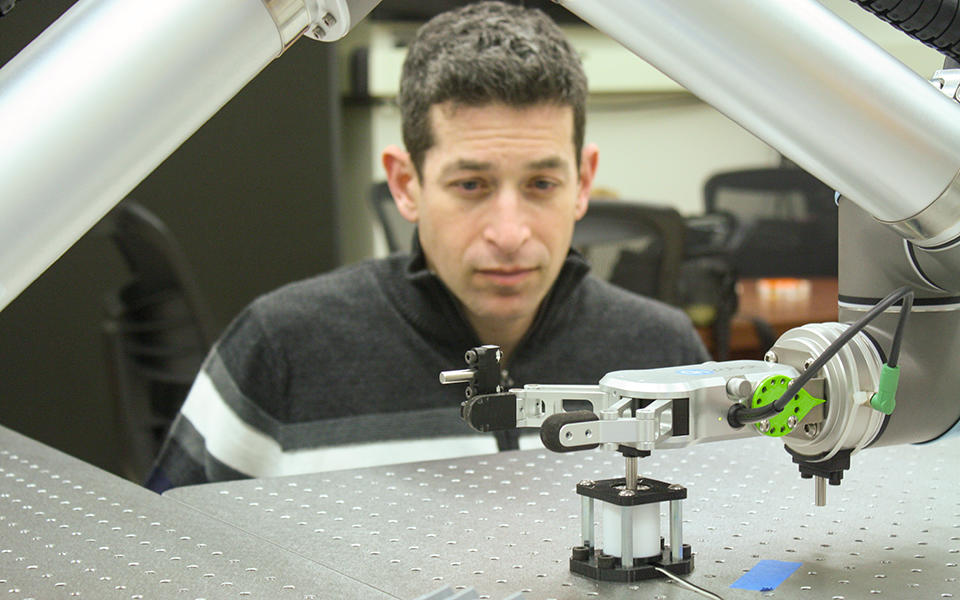Taking Measure
Just a Standard Blog

Overseeing my robot's operation.
The National Institute of Standards and Technology (NIST) is a world-class research organization. We have phenomenal scientists and engineers with impeccable research credentials. Our researchers are experts in a range of fields including artificial intelligence, cybersecurity, fire, forensics, infrastructure, manufacturing and public safety. They are constantly pushing the boundaries of theoretical and applied research. I am often in awe when I learn of the new groundbreaking results my colleagues achieve.
However, while we do great research, we don’t stop there. Our work doesn’t end until our target stakeholders, the American taxpayers, put our technologies and capabilities to work for themselves, so they can grow their businesses, be more profitable, and thrive on the world stage.
What I’m talking about is technology transfer. Simply put, technology transfer is the activity of packaging research into industry-consumable pieces, broadcasting the research to the appropriate communities, and promoting the adoption of these new technologies. I'm a big fan of technology transfer, and I’m thrilled to share my experiences with you!
It all starts with my research.
Have you ever played the game Operation before? Operation is a game made by Hasbro where you are the doctor. Your goal is to remove pretend body parts from a comic patient without touching the sides of the openings where the body parts are. If you touch the sides with the metal tweezers, then the patient’s red nose lights up to indicate that you failed. Pretty simple, right? Of course, if your doctor were to play this game, and you were the patient, you’d like the doctor to be consistently accurate and never touch the sides. As doctors get older or if they get injured, they may have a hard time maintaining the required level of accuracy. Their actions may no longer be repeatable, and they now regularly “touch the sides.”
Now think about a robot arm playing this game. Suppose I program a robot to move to some specific point in the world — let’s call this point “A.” I expect the robot to move to point A (plus or minus some level of precision) every time I run this program.
So, what happens if I run the move to point A program and the robot fails to move to point A? Instead of point A, it ends up 0.01 millimeter off or 1 mm off. Depending upon the process, a 1-mm error could be perfectly acceptable. Another process could have tighter requirements where something as minor as a 0.01-mm error is unacceptable.
Inaccurate movements can substantially impact a robot’s day job, especially if that robot is trying to weld a car frame or drill a hole in an airplane fuselage. These types of errors can lead to bad parts, which cost the manufacturer time and money. Also, would you want to buy or drive a car that has inaccurate welds that could cause the frame to fail? I think all of us would answer “no!”
What has caused this error in the robotic system’s positioning? Good question — there can be a few reasons, many of which have to do with the robot or another part of the system, such as the robot’s gripper, being degraded due to wear and tear. So how do we measure the degradation of the robotic system’s positioning accuracy when we don’t know exactly where the problem is? A former team member and I developed a novel test method and companion sensor that allows the users to get a sense of where degradation has occurred within the robot’s overall operation.
To date, the test method has been demonstrated successfully in the lab, and we’ve obtained some preliminary data. We’ve also done some measurements of the sensor itself to better understand its performance. Moreover, I am developing the next generation of the sensor to increase the volume of information that the test method can capture when it’s executed.
So, what do I do now? Of course, I will continue to publish conference papers and journal articles, maintain a project webpage, and present this research at various events, but I don’t think that’s enough. In my humble opinion, there’s no substitute for taking it further outside of NIST. I know I will get invaluable feedback by involving the intended consumers of the test method and companion sensor. For me, independent organizations taking steps to commercialize my technology is proof that the industry wants it on their factory floors.
Some of the vehicles we have in place at NIST to roll out technologies and work with our stakeholders include Small Business Innovation Research (SBIR) awards, Cooperative Research and Development Agreements (CRADAs), and cooperative agreements. Similarly, I engaged external partners to promote technology transfer. FedTech is one such partner I have interacted with following an introduction from NIST’s Technology Partnership Office. Their focus is on connecting government inventors with entrepreneurs for potential commercialization of government-developed technologies.
I have several active collaborations that involve SBIRs, CRADAs and cooperative agreements in some way, shape or form. Collectively, I am leveraging these mechanisms to advance the research and development of this test method, and verify and validate both the test method and companion sensor, along with generating reference datasets, test method implementation guidance, and best practices to further understand the health of robotic manufacturing systems. This is all in addition to putting out numerous publications that clearly document the successes and lessons learned throughout. In each collaboration, the external partner offers unique and valuable perspectives, which further enhance the value of NIST’s research and technology for our target audience. It’s great that I have all these vehicles to put my technology “on the street.”
NIST and every collaborator stand to gain from their partnerships. NIST researchers like me get to further their research by putting it to the test in the real world, and industry partners get a firsthand look at emerging NIST technologies to better understand how they can work for them and their customers.
That’s what I call a win-win!
About the author
Related Posts
Comments
Suggestion to fix the robot’s positioning error due to wear and tear. Perform life cycle test of robot in lab conditions, determine estimated time to replace a priori, the robot performing repetitive tasks, with a redundant robot on a rotating platform to continue the positioning operation and use Mr Weiss’ diagnostic algorithms to detect, diagnose and restore the defective robot to its virgin condition. Appreciate the innovative work of NIST.
‘
So, does the taxpayer receive some monetary compensation from the transfer of these inventions to private enterprise and why are wealthy corporations not developing these technologies for themselves? It seems a bit like private corporations are taking advantage of taxpayers by allowing taxpayers to foot the bill for key technological research and development. Is it possible to request a royalty be paid back to NIST for instance or DARPA thus reducing tax burden if a technology is transferred to a private corporation etc. ?
According to our Technology Partnerships Office many of NIST’s commercial licenses do collect royalty payments and that in accordance with 15 USC 3710c royalties are shared with the inventors and their laboratories in order to support the mission of the lab through research and training. For more information, please see https://www.nist.gov/tpo/licensing-nist-technologies
Interesting!






Observation......
Engage external partners that aren’t so much focused on profiting in terms of money but rather in terms of engendering interest in their momentary insights and thereby from time to time making truly extraordinary contributions. Contributions that, in and of themselves, are most wonderfully - “The Reward!”